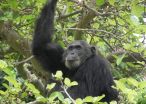(Press-News.org) Infectious disease should be a key consideration in wildlife conservation, suggests a study focused on primates in Tanzania's Gombe Stream National Park, published by PLOS Neglected Tropical Diseases. The study investigated the parasite Cryptosporidium and cross-species transmission risks among humans, wild primates and domesticated animals within the greater Gombe ecosystem.
"We found that people are likely exposing the endangered chimpanzees of Gombe to a particular species of Cryptosporidium, which may be contributing to their decline," says Michelle Parsons, a PhD student in Emory University's departments of Environmental Sciences and Environmental Health. "It appears to be a case of spillover, or exchange of a pathogen, from humans to animals, instead of the other way around."
The spillover of any one pathogen between species, Parson adds, "is an indicator that an ecological connection exists, with potential for other pathogens to emerge."
The study also revealed that some of the chimpanzees are infected with a species of Cryptosporidium associated with pigs. "No domesticated pigs reside in the village just outside the park, so we think it's likely that the source of infection is wild pigs living in the forest," Parsons says.
In addition to being a student in Emory's Population Biology, Ecology and Evolution Graduate Program, Parsons is a research microbiologist at the Centers for Disease Control and Prevention's Division of Foodborne, Waterborne and Environmental Diseases.
She led the study with her PdD adviser, disease ecologist Thomas Gillespie, a professor in Emory's Department of Environmental Sciences and Rollins School of Public Health's Department of Environmental Health.
"When it comes to protecting endangered species, the focus is often limited to providing habitat and preventing hunting," Gillespie says. "But disease also matters in conservation, and that's a relatively new message. Our research shows that if we're going to keep these iconic chimpanzees on the planet, we need to address the spread of infectious diseases."
Gombe is the site where Jane Goodall conducted her pioneering research into the behavior of wild chimpanzees, beginning in 1960. Goodall's project is now the longest field study of any animal. Each individual chimpanzee has been identified, and its maternal line is known.
Despite the fact that Gombe became a protected wildlife park in 1968, the chimpanzee population there is on the decline, down from about 150 chimpanzees 20 years ago to 100 today.
The Gillespie lab is one of the few investigating the ecology and epidemiology of infectious disease in natural systems where domesticated animals, humans and wildlife overlap.
Cryptosporidium, or "Crypto," is one of the most frequent causes of waterborne disease in the United States, and is among the top four cases of moderate-to-severe diarrheal disease in young children in developing nations. Crypto is particularly dangerous for people infected with HIV, who tend to have more severe cases that can be fatal. Studies have also shown that chimpanzees infected with SIV (the ancestor of HIV) have a reduced lifespan and may be more vulnerable to opportunistic infections.
The researchers collected fecal samples from a cross-section of chimpanzees, baboons, humans, and domesticated dogs, goats and sheep within the greater Gombe ecosystem. The results revealed Crypto infection rates of about 16 percent in the wild primates, 4 percent in humans and 10 percent in the goats and sheep.
DNA sequencing uncovered a complex epidemiology for Crypto in this system, with humans, baboons and a subset of chimpanzees infected with C. hominis (which is most closely associated with humans), and another subset of chimpanzees infected with C. suis, (usually associated with pigs). All the positive sheep and goats were infected with C. xiaoi (a subtype associated with livestock).
"The dominance of C. hominis among humans and non-human primates suggest cross-species contamination," the study authors write.
The baboons are known to raid human homes and trash for food, while the chimpanzees raid agricultural fields just outside the park boundaries. These behaviors expose the wild primates to the potentially contaminated feces of livestock or exposed human sewage.
Although water samples screened in the study were negative for Crypto, waterborne outbreaks of Crypto as a result of human and animal fecal contamination are common. "Homes with positive livestock had a tendency for increased risk of human infection, suggesting contribution of environmental factors or behaviors that may place the household at increased risk," the study authors write.
The findings highlight the complex nature of zoonotic parasite transmission and stress the need for further studies, Parsons says. "It's important to understand the ecology of diseases for both wildlife conservation and for human health. We need good baseline data in order to monitor emerging pathogens."
INFORMATION:
Co-authors of the study include researchers from the University of Minnesota, Franklin and Marshall College, the Jane Goodall Institute and the Henan Center for Disease Control and Prevention.
Computers that function like the human brain could soon become a reality thanks to new research using optical fibres made of speciality glass.
The research, published in Advanced Optical Materials, has the potential to allow faster and smarter optical computers capable of learning and evolving.
Researchers from the Optoelectronics Research Centre (ORC) at the University of Southampton, UK, and Centre for Disruptive Photonic Technologies (CDPT) at the Nanyang Technological University (NTU), Singapore, have demonstrated how neural networks and synapses in the brain ...
Scientists on two continents have independently discovered a set of celestial objects that seem to belong to the rare category of dwarf satellite galaxies orbiting our home galaxy, the Milky Way.
Dwarf galaxies are the smallest known galaxies, and they could hold the key to understanding dark matter, and the process by which larger galaxies form.
A team of researchers with the Dark Energy Survey, headquartered at the U.S. Department of Energy's Fermi National Accelerator Laboratory, and an independent group from the University of Cambridge jointly announced their findings ...
People who lose their jobs are less willing to trust others for up to a decade after being laid-off, according to new research from The University of Manchester.
Being made redundant or forced into unemployment can scar trust to such an extent that even after finding new work this distrust persists, according to the new findings of social scientist Dr James Laurence. This means that the large-scale job losses of the recent recession could lead to a worrying level of long-term distrust among the British public and risks having a detrimental effect on the fabric of society.
Dr ...
DARIEN, IL - A new study finds that obstructive sleep apnea is associated with a significantly increased risk of motor vehicle accidents, and this risk is reduced when sleep apnea is treated effectively using continuous positive airway pressure (CPAP) therapy.
Results show that patients with sleep apnea were nearly 2.5 times more likely to be the driver in a motor vehicle accident, compared with a control group of other drivers in the general population. Further risk analysis found that severe excessive daytime sleepiness, a short sleep duration of 5 hours or less, and ...
Many mammals -- and some birds -- escape the winter by hibernating for three to nine months. This period of dormancy permits species which would otherwise perish from the cold and scarce food to survive to see another spring. The Middle East, with temperate winters, was until recently considered an unlikely host for hibernating mammals.
New research published in Proceedings of the Royal Society of London by Tel Aviv University researchers is set to not only correct this fallacy but also change the very concept of hibernation. Prof. Noga Kronfeld-Schor, Chair of the Department ...
Natural forces have always caused the climate on Earth to fluctuate. Now researchers have found geological evidence that some of the same forces as today were at play 1.4 billion years ago.
Fluctuating climate is a hallmark of Earth, and the present greenhouse effect is by far the only force affecting today's climate. On a larger scale the Earth's climate is also strongly affected by how the Earth orbits around the sun; this is called orbital forcing of climate change. These changes happen over thousands of years and they bring ice ages and warming periods.
Now researchers ...
COLUMBUS, Ohio - New clinical-trial findings provide further evidence that combining chemotherapy with radiation therapy is the best treatment for people with a low-grade form of brain cancer.
The findings come from a phase II study co-led by a researcher at Ohio State University Comprehensive Cancer Center - Arthur G. James Cancer Hospital and Richard J. Solove Research Institute (OSUCCC - James) and researchers at the University of Maryland and at London Regional Cancer Program in Ontario, Canada.
The study shows that patients with low-grade gliomas and at high risk ...
Established ways of measuring carbon emissions can sometimes give misleading feedback on how national policies affect global emissions. In some cases, countries are even rewarded for policies that increase global emissions, and punished for policies that contribute to reducing them.
"We have developed a new method that provides policy makers with more useful information, in order to set national targets and evaluate their climate policies", says Astrid Kander, Professor in Economic History at Lund University, and lead author of the study, published in the latest issue ...
What inspires people to support conservation? As concerns grow about the sustainability of modern society, this question becomes more important. A new study by a team of researchers from Clemson University and Cornell University offers one simple answer: birdwatching and hunting.
Their survey of conservation activity among rural landowners in Upstate New York considered a range of possible predictors, such as gender, age, education, political ideology and beliefs about the environment. All other factors being equal, birdwatchers are about five times as likely, and hunters ...
A study of a recently discovered fossil published by LMU zoologists reveals the specimen to be the oldest known crab larva: The fossil is 150 million years old, but looks astonishingly modern.
To catch living crab larvae, all you have to do is trawl a plankton-net in the nearest bay or tidal pool. Finding fossilized crab larvae is rather more difficult - as witnessed by the fact that the specimen described in "Nature Communications" today by Ludwig-Maximilians-Universitaet (LMU) in Munich zoologists Joachim and Carolin Haug, and Joel Martin of the Natural History Museum ...


